Tenants
Tenants section allows you to manage multiple organizations on the same server or a cluster of servers. Tenants are completely independent and unaware of each other. Each Tenant's User Extensions, VM Mailboxes, Phones, IVR/Voice Menus, Media Files (announcements and Music-on-Hold), and any other objects are managed independently.
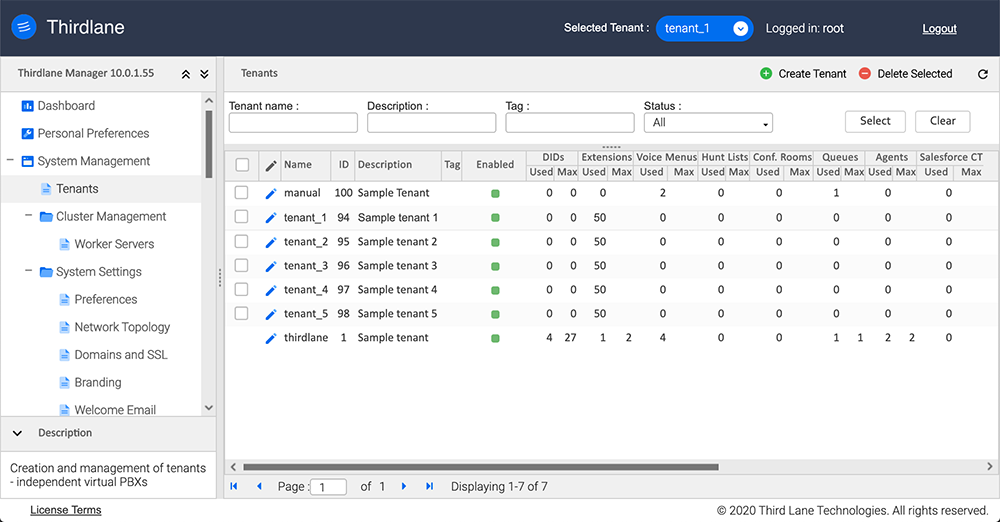
Create/Edit Tenant
You should not create new Tenants "from scratch". Create them by cloning "template/prototype" Tenants with typical default settings.
General Settings
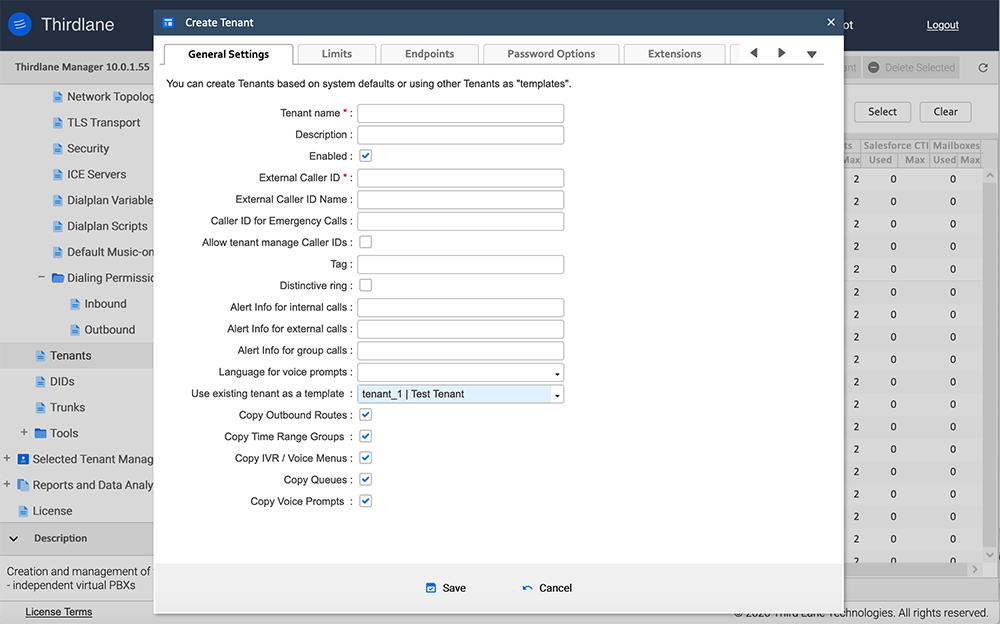
Tenant name. Unique lowercase alphanumeric name for the Tenant (no spaces or dashes are allowed).
Tenant ID. This field is only shown when editing an existing Tenant. Used internally by Thirdlane.
Status. Tenant status (enabled/disabled). This allows a system administrator to temporarily disable the Tenant (all calls originating from the phones associated with the Tenant will be disabled).
Default External Caller ID. You can set a default caller id for the Tenant by specifying one of the DIDs of the Tenant. Note that whether this caller id will be available to the called party is dependent on your service provider.
Default External Caller ID Name. Default caller id name for the Tenant. Note that whether this caller id will be available to the called party is dependent on your service provider.
Caller ID for Emergency Calls. Alternative caller id for emergency calls as defined in Outbound Routes.
Allow tenant to manage Caller IDs. You can use this field to allow a Tenant level administrator to set up their own caller id. Alternatively, you can set the caller id for the Tenant and prevent them from modifying it. This caller id will appear when outbound calls are made by the phones associated with the Tenant. Note that whether this caller id will be available to the called party is dependent on your service provider.
Distinctive ring. Enables Alert-Info SIP header insertion based on the next three settings.
Alert Info for internal calls. Alert-Info SIP header value for incoming internal calls.
Alert Info for external calls. Alert-Info SIP header value for incoming external calls.
Alert Info for group calls. Alert-Info SIP header value for incoming calls via Hunt Lists.
Language for voice prompt. Sets language for voice prompts based on the installed Sound Packages where you can install additional languages.
Use existing tenant as a prototype. This field is shown only when creating a new Tenant and allows you to use an existing Tenant as as a prototype (or template) and copy prats of this Tenant configuration when creating a new Tenant. If you select a "Tenant to “clone”, you will be provided with a list of options for specifying which parts of the configuration will be copied.
Limits
This section allows you to specify limits (maximum number of various types of objects) for the Tenant.
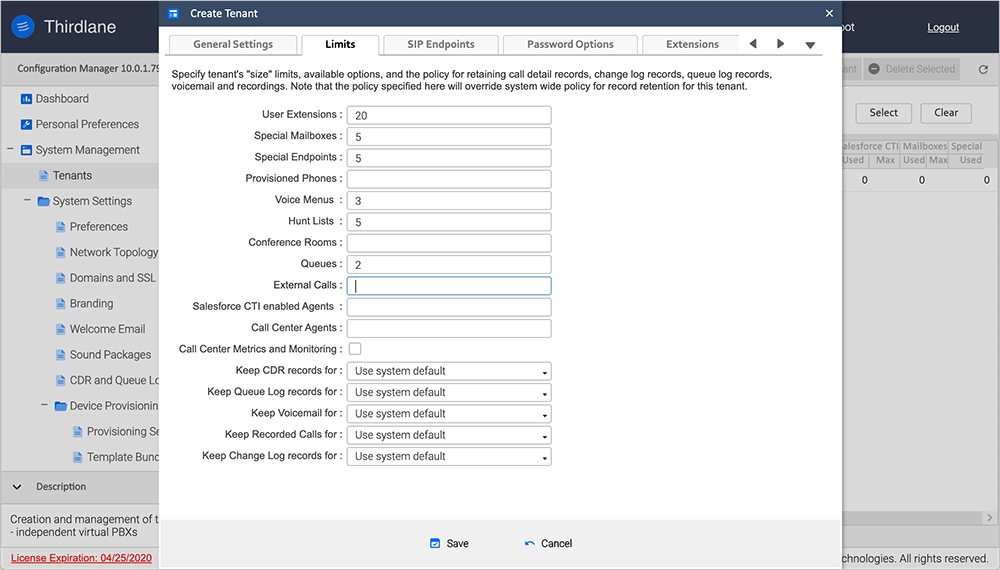
Number of User Extensions. By default the number of User Extensions that can be created for a Tenant is unlimited. Entering a number in this field will limit the number of User Extensions.
Note that the total number of User Extensions can not exceed the number of User Extensions as defined by your license.
Number of Special Mailboxes. By default the number of Special Mailboxes that can be created for a Tenant is unlimited. Entering a number in this field will limit the number of voicemail Special Mailboxes.
Number of Special Endpoints. By default the number of Special Endpoints (other than the User Extensions) that can be created for a Tenant is unlimited. Entering a number in this field will limit the number of Special Endpoints.
Number of Provisioned Phones. By default the number of Managed Devices (that can be created in auto-provisioning) for a Tenant is unlimited. Entering a number in this field will limit this number.
Number of Voice Menus. By default the number of Voice Menus that can be created for a Tenant is unlimited. Entering a number in this field will limit the number of Voice Menus.
Number of Hunt Lists. By default the number of Hunt Lists that can be created for a Tenant is unlimited. Entering a number in this field will limit the number of Hunt Lists.
Number of Conference Rooms. By default the number of Conference Rooms that can be created for a Tenant is unlimited. Entering a number in this field will limit the number of Conference Rooms.
Number of Queues. By default the number of Queues that can be created for a Tenant is unlimited. Entering a number in this field will limit the number of Queues.
Number of External Calls. By default the number of concurrent External Calls that can be made by a Tenant is unlimited. Entering a number in this field will limit the number concurrent of inbound and outbound external calls.
Salesforce CTI enabled Agents. Number of Call Center Agents that can use Thirdlane Salesforce CTI integration. Empty means none.
Number of Call Center Agents. Number of Call Center Agents. Emptu means none.
Call Center Metrics and Monitoring. This is shown only if you have Call Center license, and enables Call Center Metrics and Monitoring functionality and corresponding menu items for this Tenant.
Keep CDR records for. Define for how long CDR records will be kept.
Keep Queue Log records for. Define how long Queue Log records will be kept.
Keep Voicemail for. Define for how long Voicemail messages will be kept.
Keep Recorded Calls for. Define for how long limit to keep recorded calls.
Keep Change Log records for. Define for how long to keep Change Log records.
Endpoints
These options are used in Bulk Generator and as defaults on the User Extension screen.
Note that the Tenant settings override system-wide Default Values.
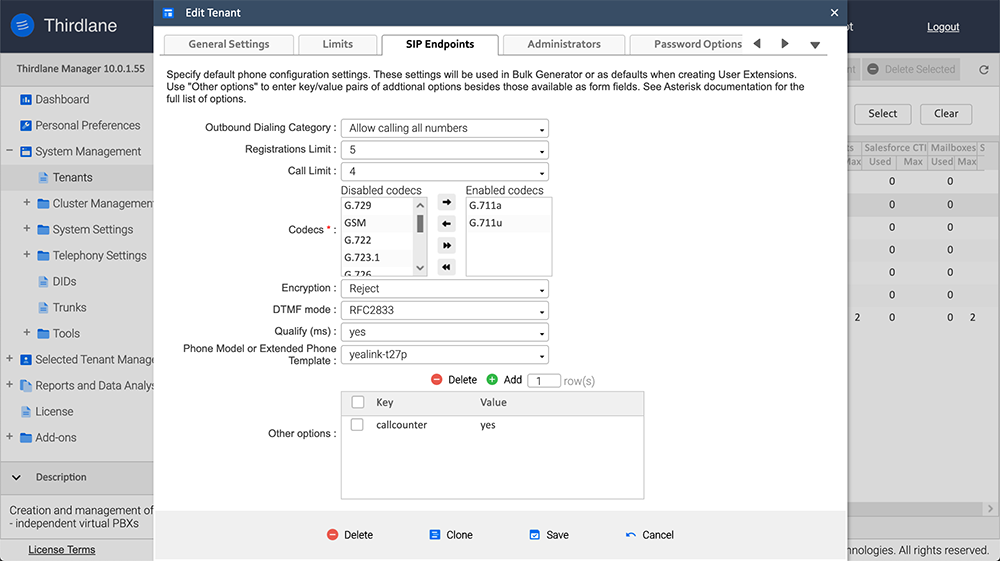
Outbound Dialing Category. Determines what calls SIP Endpoints are allowed to make, i.e. which destinations managed in Outbound Routes will be available - all, unrestricted or only internal and emergency.
Registrations Limit. Specify a number of devices that can register under a SIP account.
Call Limit. Specify a maximum number of concurrent calls for a SIP account.
Enabled codecs. Codecs that are enabled for SIP Endpoints.
Disabled codecs. Codecs that are disabled for SIP Endpoints.
Encryption. Options for encrypting calls.
Available options are:
- Enforce. Make all the outbound calls encrypted and accept only encrypted inbound calls.
- Reject. Make all the outbound calls unencrypted and accept only unencrypted inbound calls.
- Negotiate, trying encrypted first. Try to make encrypted outbound calls first, and if that fails, fall back to unencrypted. Accept both encrypted and unencrypted inbound calls.
- Negotiate, trying unencrypted first. Try to make unencrypted outbound calls first, and if that fails, fall back to encrypted. Accept both encrypted and unencrypted inbound calls.
DTMF mode. Must match DTMF mode specified by your VoIP service provider.
Qualify (ms). Enable and specify the amount of time the server waits for keepalive packets. Value of "yes" corresponds to 2000 ms.
Voicemail Retrieval Extension. Dialplan extension to reach mailbox.
Other Options. This section allows you to specify additional options that don't have corresponding GUI fields. Specify any additional options in the key=value form. Each pair should be entered on a separate line.
Administrators
This section is only shown when editing an existing Tenant. Typically you would create a Tenant Level Administrator for each Tenant. If necessary, you can limit their access rights, for example, you may not allow these users to manage Trunks, Routes, Inbound Routes.
Note that the root user or any user with the permission “to manage all tenants” will be able to manage any Tenant.
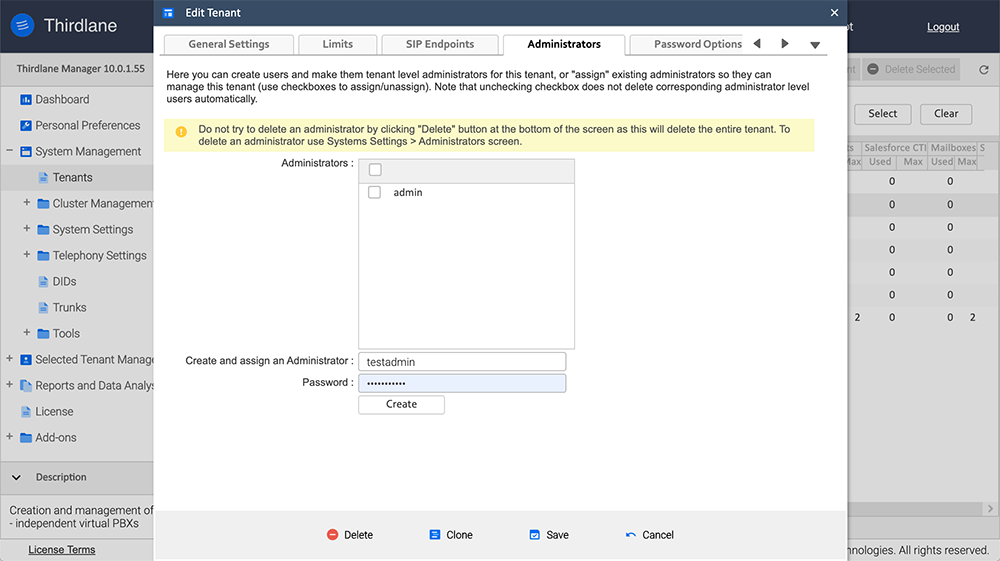
Administrators. List of users who are allowed to manage this Tenant.
Add an Administrator. This field is only shown when editing an existing Tenant and allows you to add Tenant level administrator(s).
Password options
In this section, you can specify how passwords will be generated.
Note that the Tenant settings override system-wide Default Values.
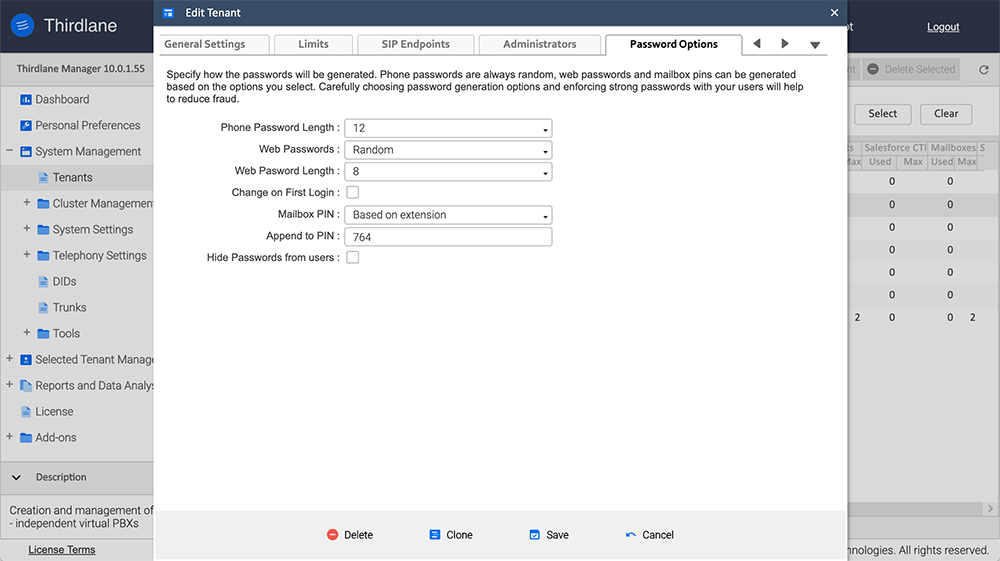
Phone Password Length. Length of randomly generated passwords when using Bulk Generator or pre-filled on the User Extension screen when creating individual User Extensions.
Web Passwords. Specify how the web passwords are generated. The options are:
- Random.
- Based on extension. When using this option you can specify a string that will be appended to the extension based passwords.
- Based on default. When using this option you can specify the default password and a string that will be added to the passwords.
Web Password Length. Specify the length of the generated web passwords.
Change on First Login. Specify whether the web passwords have to be changed during the first login.
Mailbox PIN. Specify how the mailbox PINs are generated. The options are:
- Random.
- Based on extension. When using this option you can specify a string that will be appended to the extension based PINs.
- Based on default. When using this option you can specify the default PIN and a string that will be added to the PINs.
Append to PIN. Specify a text string to append to generated PINs.
Hide Passwords from users. Specify whether phone passwords will be hidden from users.
Extensions
These section allows you to specify User Extension creation options, that are used in Bulk Generator and as defaults on the User Extensions screen.
Note that the Tenant settings override system-wide Default Values.
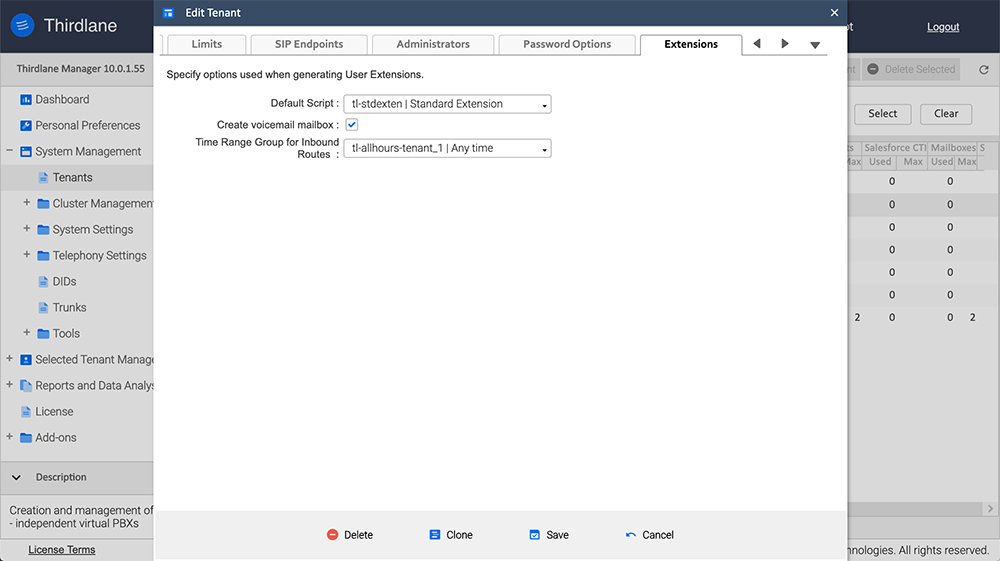
Default Script. Allows selecting a default script for handling calls to User Extensions.
Create voicemail mailbox. Allows specifying whether User Extensions will have voicemail enabled.
Time Range Group for Inbound Routes. Default Time Range Group to be used when automatically generating Inbound Routes for created User Extensions.
User Settings
In this section, you can specify User Extension owners' permissions and options for User Portal and Thirdlane Connect.
Note that the Tenant settings override system-wide Default Values.
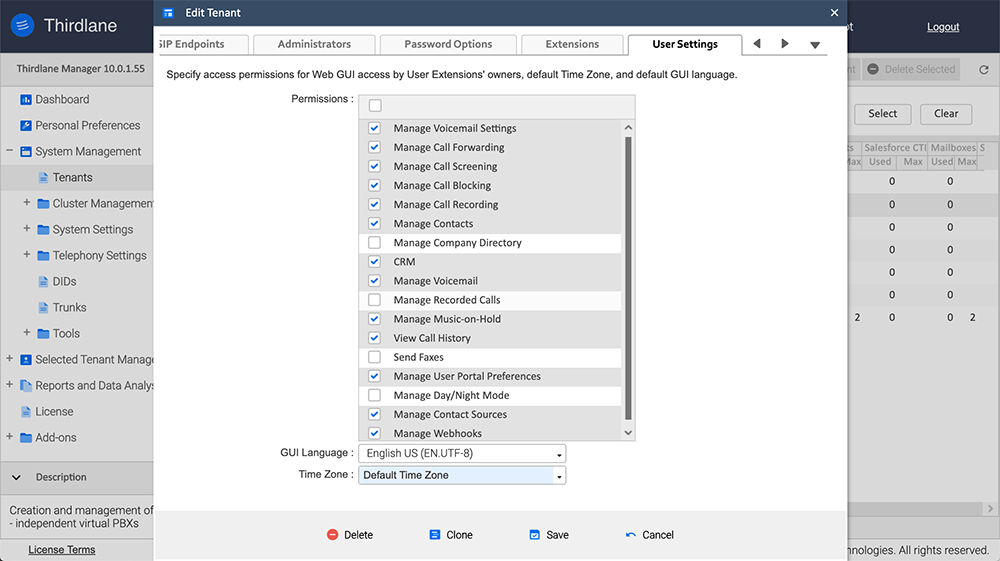
Permissions. User Portal and Thirdlane Connect permissions.
GUI Language. Language for User Portal and Thirdlane Connect.
Time Zone. Time Zone of this Tenant. Select a Time Zone from a list of time zones, or leave it as the system-wide default.
Conferencing
This section allows you to specify the default values used when creating Conference Rooms.
Note that the Tenant settings override system-wide Default Values.
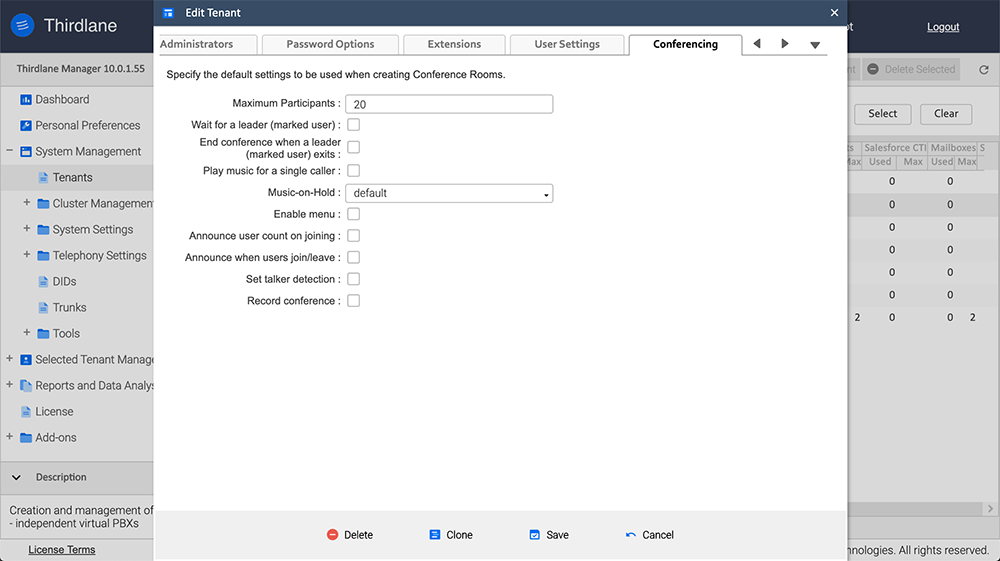
Maximum Participants. Maximum number of participants that are allowed to join a conference.
Wait for a leader (marked user). Wait until the marked user enters the conference. If set will make users wait for a marked user (In Configuration Manager a user who enters administrator's password is considered to be the marked user).
End conference when a leader (marked user) exits. This option will end the conference for everyone after the last marked user exits.
Play music for a single caller. If set, will enable music-on-hold even when conference the has a single caller.
Music-on-Hold. Music-on-hold associated with the conference which plays when users are waiting for a marked user.
Enable menu. If set, will allow a voice menu. The options presented are dependent on whether it is a regular user or an administrator who presses the key and includes muting and unmuting, increasing or decreasing volume, etc.
Announce user count on joining. If set, will play announce a user count to users joining the conference.
Announce when users join/leave. If set, will play an announcement every time someone joins or leaves the conference.
Set talker detection. If set, will send information about the current talkers to the Asterisk Manager Interface
Record conference. If set, then the conference will be recorded. Use this with caution as the recordings can be quite large.
Voicemail
In this section, you can specify settings for Roicemail handling.
Note that the Tenant settings override system-wide Default Values.
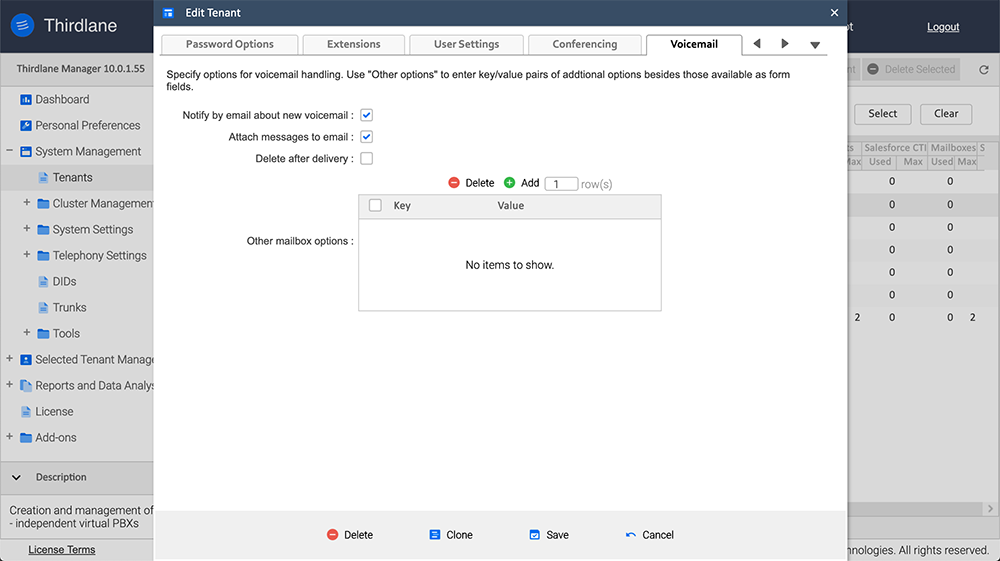
Notify by email about new voicemail. Determines whether the users will be notified about new voice mail messages via email.
Attach messages to email. Determines whether the voicemail message will be attached to the notification email.
Delete after delivery. Determines whether voice mail messages will be deleted after they are delivered via email.
Other mailbox options. This section allows you to specify additional options that don't have corresponding GUI fields. Specify any additional options in the key=value form. Each pair should be entered on a separate line.
Call Recording
In this section, you can specify Call Recording options for calls from/to User Extensions.
Note that the Tenant settings override system-wide Default Values.
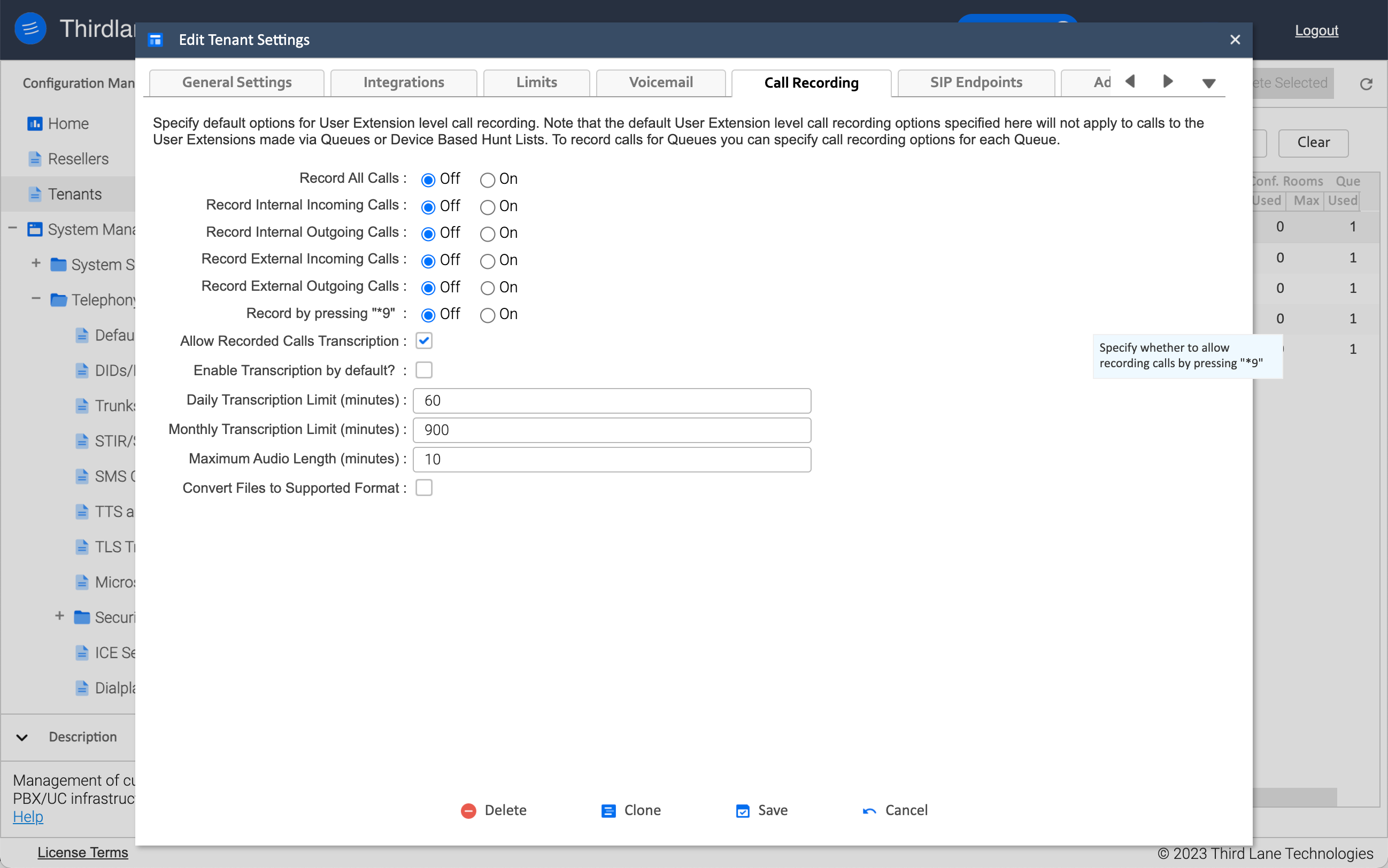
Record All Calls. Specify whether all calls to/from User Extensions will be recorded.
Record Internal Incoming. Specify whether the internal calls to User Extensions will be recorded.
Record Internal Outgoing. Specify whether the internal calls from User Extensions will be recorded.
Record External Incoming. Specify whether the external calls to User Extensions will be recorded.
Record External Outgoing. Specify whether the external calls from User Extensions will be recorded.
Record by pressing *9. Specify whether the owners of User Extensions will be able to record calls by pressing *9.
Allow Recorded Calls Transcription. Specify whether Recorded Calls Transcription will be available.
Enable Transcription by default? Specify whether Transcription will be enabled by default when creating User Extensions.
Daily Transcription Limit (minutes). Specify the Daily Limit of Recorded Calls Transcription for this tenant.
Monthly Transcription Limit (minutes). Specify the Monthly Limit of Recorded Calls Transcription for this tenant.
Maximum Audio Length (minutes). Specify the Maximum Audio Length (minutes) of each Recorded Call that will be transcribed.
Convert Files to Supported Format. Specify whether the audio files in the format not supported by transcription service provider should be converted to a supported format automatically. This conversion creates extra load on the server, but is useful when you store compressed recordings but still require transcription.
Faxing
In this section, you can specify this Tenant's settings for outbound Faxing.
Note that the Tenant settings override system-wide Default Values.
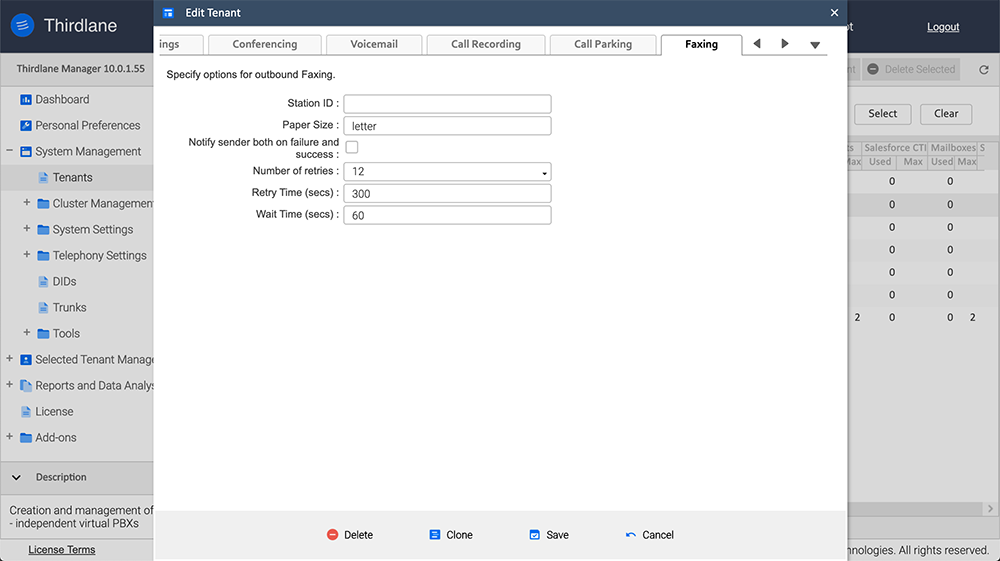
Station ID. Station ID is transmitted to the recipient when an outgoing fax is sent. It may appear on the display of the recipient's fax machine, usually consists of the sender's fax number and business name and is limited to 20 characters.
Paper Size. Paper size for sending faxes, "letter" is the default.
Notify sender both on failure and success. Specify whether fax senders will be notified both on failure and success.
Number of retries. Number of retries before giving up when sending a fax.
Retry Time (secs). Time to wait after an unsuccessful attempt.
Wait Time (secs). Time to wait for the result after the fax is sent.
ICE
In this section, you can specify this Tenant's settings for Interactive Connectivity Establishment (ICE) Protocol for NAT traversal.
Note that the Tenant settings override system-wide Default Values.
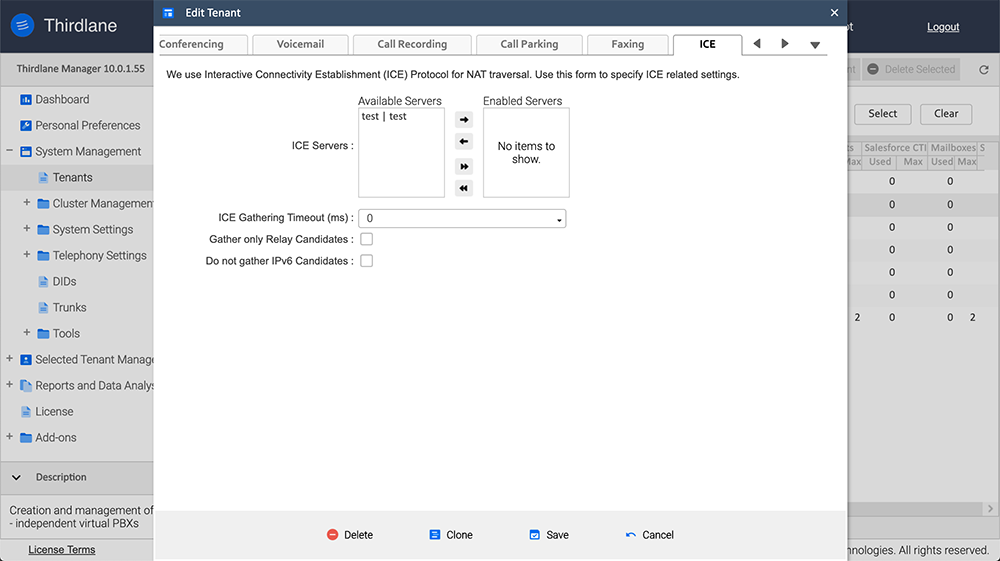
ICE Servers. Select a default ICE Server from a list of existing ICE Servers
ICE Gathering Timeout (ms). Sets the timeout for ICE candidate gathering procedure. The default value is 3000.
Gather only Relay Candidates. Includes only candidates obtained from a relay server, such as a TURN server.
Do not gather IPv6 Candidates. Excludes ICE candidates with IPv6 addresses.
Welcome Email
In this section you can override global settings for sending Welcome Email and modify the template for this tenant here.
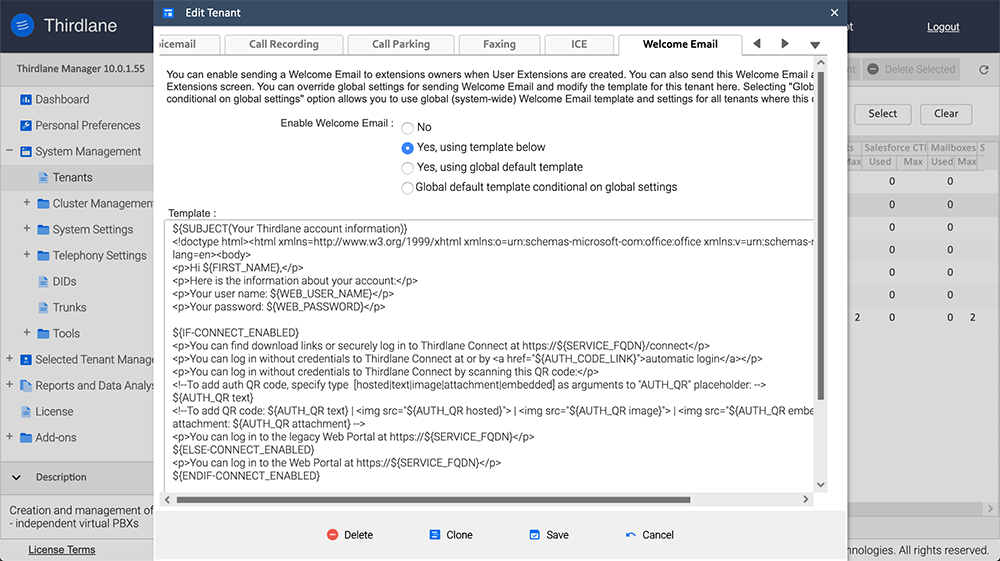
Enable Welcome Email. Select an option for selecting a template and sending a Welcome Email to users when User Extensions are created.
Available options are:
- No.
- Yes, using template below.
- Yes, using global default template.
- Global default template conditional on global settings.
Selecting "Global default template conditional on global settings" option allows you to use global (system-wide) Welcome Email template and global option for sending.